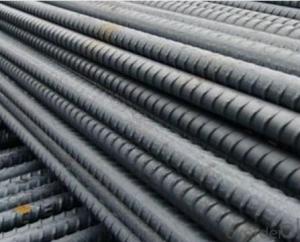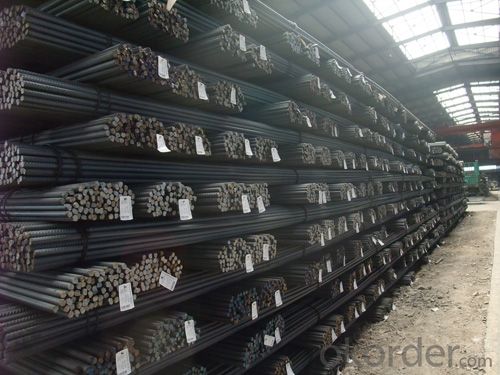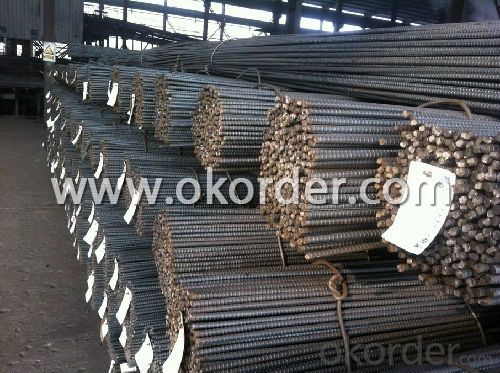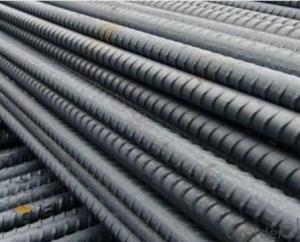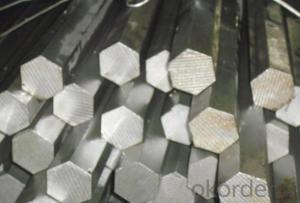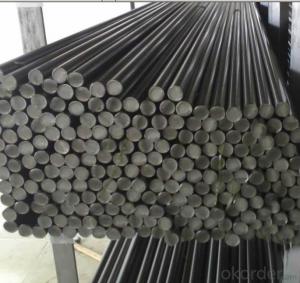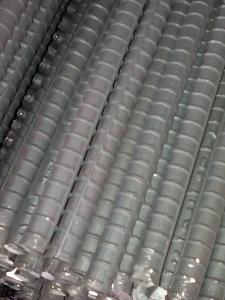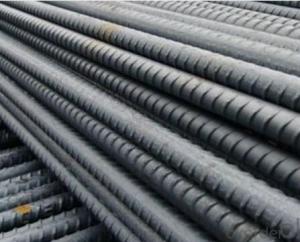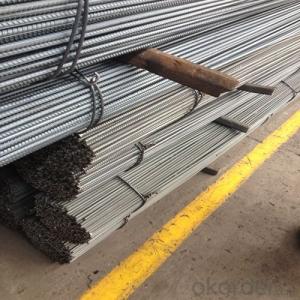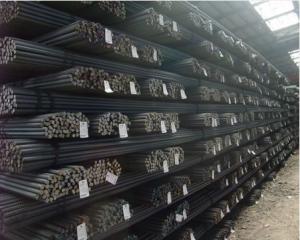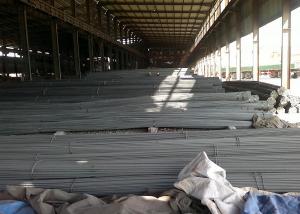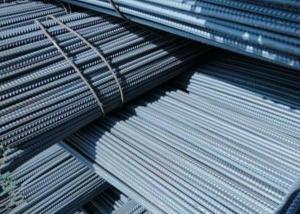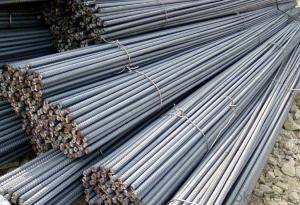HIGH QUALITY HOT ROLLED STEEL REBARBS STANDARD
- Loading Port:
- Tianjin
- Payment Terms:
- TT OR LC
- Min Order Qty:
- 50 m.t.
- Supply Capability:
- 100000 m.t./month
OKorder Service Pledge
OKorder Financial Service
You Might Also Like
Product Description:
Specifications of Hot Rolled Steel Rebar:
The production process of Steel Rebar
1-Waling beam furnace 2-Roughing rolling group 3-Intermediate rolling train
4-Finishing rolling group 5-Water-cooling device 6-Walking beam cooler
7-Finishing equipment(including the cold scale shear,short feet collection system,
automatic counting device,bundling machine, collect bench)
Usage and Applications of Hot Rolled Steel Rebar:
Deformed bar is widely used in buildings, bridges, roads and other engineering construction. Big to highways, railways, bridges, culverts, tunnels, public facilities such as flood control, dam, small to housing construction, beam, column, wall and the foundation of the plate, deformed bar is an integral structure material. With the development of world economy and the vigorous development of infrastructure construction, real estate, the demand for deformed bar will be larger and larger..
Packaging & Delivery of Hot Rolled Steel Rebar:
Packaging Detail: products are packed in bundle and then shipped by container or bulk vessel, deformed bar is usually naked strapping delivery, when storing, please pay attention to moisture proof. The performance of rust will produce adverse effect.
Each bundle weight: 2-3MT, or as required
Payment terms: TT payment in advance or Irrevocable LC at sight.
Trade terms :FOB, CFR, CIF
Label:to be specified by customer, generally, each bundle has 1-2 labels
Note:
1. Our products are produced according to national standard (GB), if not, supply according to national standards (GB) or agreement as customer required.
2. Other Grade and Standard Deformed Steel Bar we can supply:
Grade: GR40/GR60, G460B/B500A/B500B/B500C,BST500S
Standard: ASTM, BS, DIN
The Minimum Order Quantity of these products is high, and need to be confirmed.
3. We can not only supply Deformed Steel Bar; if you need anything about building materials, please contact us for further information.
4. Please send us your detail specifications when inquire. We will reply to you as soon as possible. We sincerely hope we can establish a long stable business relationship.
- Q: How do steel rebars contribute to the overall sustainability of the construction industry?
- Steel rebars contribute to the overall sustainability of the construction industry in several ways. Firstly, steel rebars are made from recycled materials, reducing the demand for new resources and minimizing the environmental impact of steel production. Additionally, steel rebars are highly durable and have a long lifespan, ensuring the longevity and stability of structures, reducing the need for frequent repairs or replacements. Moreover, the use of steel rebars in reinforced concrete allows for the construction of taller and more complex structures, maximizing the efficient use of land and reducing the need for additional construction projects. Overall, steel rebars play a crucial role in improving the sustainability of the construction industry by promoting resource conservation, durability, and efficient construction practices.
- Q: Can steel rebars be used in wastewater treatment plant construction?
- Yes, steel rebars can be used in wastewater treatment plant construction. Steel rebars are commonly used in the construction of reinforced concrete structures, including wastewater treatment plants. They provide additional strength and durability to the concrete, helping it withstand the harsh conditions and corrosive environment often found in wastewater treatment facilities. The rebars are typically coated with epoxy or other corrosion-resistant materials to protect them from the corrosive effects of wastewater. Additionally, proper design and placement of the rebars ensure structural integrity and longevity of the treatment plant. Overall, steel rebars are a commonly used and effective reinforcement material in wastewater treatment plant construction.
- Q: What are the guidelines for protecting steel rebars during concrete placement and compaction?
- The guidelines for protecting steel rebars during concrete placement and compaction are essential to ensure the structural integrity and durability of the concrete structure. Here are some key guidelines to follow: 1. Covering and Support: Steel rebars should be adequately covered and supported to protect them from corrosion and damage. The minimum cover requirements should be met as specified in the design or relevant standards. The rebars should be positioned accurately and must not touch the ground or formwork directly. 2. Cleanliness: Before placing concrete, the rebars should be thoroughly cleaned to remove any rust, scale, dirt, or other contaminants. This can be achieved by wire brushing, sandblasting, or using other appropriate methods. Clean rebars provide a better bond with the concrete and reduce the risk of corrosion. 3. Moisture Control: The rebars should be kept dry during concrete placement and compaction. Excessive moisture can accelerate corrosion, especially in areas with high humidity or chloride exposure. Proper drainage systems and the use of waterproofing membranes can help prevent moisture accumulation. 4. Spacing and Tying: Rebars should be adequately spaced and tied together to maintain the desired concrete cover and prevent displacement during concrete placement and compaction. This ensures that the rebars are properly embedded in the concrete and provide the required structural strength. 5. Vibrating and Compaction: During concrete placement, care should be taken to prevent direct contact between the vibrator and the rebars, as this can cause damage or displacement. Vibrating should be done carefully and gradually, ensuring that the concrete is compacted uniformly and tightly around the rebars. 6. Concrete Placement Techniques: Proper concrete placement techniques should be followed to minimize the risk of rebar displacement. The concrete should be placed gently and evenly, avoiding excessive dropping or splashing that could displace the rebars. Proper compaction and consolidation techniques should also be employed to eliminate voids and ensure full encapsulation of the rebars. 7. Protection from External Factors: The rebars should be protected from environmental factors that can cause corrosion, such as exposure to moisture, chemicals, or aggressive soils. Adequate curing of the concrete is crucial to prevent rapid drying or carbonation, which can lead to corrosion and reduced durability. By following these guidelines, the rebars can be effectively protected during concrete placement and compaction, ensuring the longevity and safety of the concrete structure. It is recommended to consult the relevant design codes, specifications, and industry best practices for specific guidelines applicable to the project at hand.
- Q: What are the factors to consider while choosing the right type of steel rebar for a project?
- When choosing the right type of steel rebar for a project, several factors need to be considered. These factors include the grade and quality of the steel, the required strength and durability, the environmental conditions of the project site, the structural design and specifications, the budget, and any specific regulations or standards that need to be followed. Additionally, factors such as corrosion resistance, weldability, and availability of the steel rebar should also be taken into account. Overall, a comprehensive analysis of these factors will help in selecting the most suitable steel rebar for the project.
- Q: How do steel rebars contribute to the strength of concrete?
- Steel rebars contribute to the strength of concrete by providing reinforcement and increasing its tensile strength. The rebars are embedded in the concrete, forming a strong bond between the two materials. This helps to distribute the load evenly and prevent cracks or fractures from forming, making the concrete structure more resistant to bending, shearing, and other external forces.
- Q: What are the dimensions and sizes of steel rebars?
- Steel rebars, also known as reinforcing bars, come in various dimensions and sizes. The most common sizes range from #3 to #18, with diameters ranging from 3/8 inch to 2 1/4 inches. The length of rebars typically varies from 20 feet to 60 feet, but can also be customized to meet specific project requirements. Additionally, rebars are available in different shapes, such as round, square, or deformed, to enhance their bonding with concrete.
- Q: Can steel rebars be used in water treatment facilities?
- Yes, steel rebars can be used in water treatment facilities. Steel rebars, or reinforcing bars, are commonly used in construction projects to strengthen concrete structures. In water treatment facilities, where concrete is used for various structures such as tanks, basins, and pipelines, steel rebars are often incorporated to provide added strength and durability. Water treatment facilities involve the treatment of water to make it safe for consumption or other purposes. Concrete is a preferred material in these facilities due to its ability to withstand the harsh conditions of water treatment processes, such as exposure to chemicals, high temperatures, and pressure. Steel rebars are essential in reinforcing the concrete structures to ensure they can withstand these demanding conditions. The corrosion resistance of steel rebars is a critical factor to consider when using them in water treatment facilities. Since water treatment facilities often involve the use of chemicals and exposure to moisture, it is important to choose rebars that have appropriate corrosion protection. This can be achieved by using stainless steel rebars or by applying protective coatings to the rebars. It is also worth noting that proper design, construction, and maintenance practices are essential in ensuring the long-term performance of steel rebars in water treatment facilities. Adequate cover thickness, concrete quality, and proper installation techniques are important considerations to prevent corrosion and ensure the rebars provide the desired structural integrity. In conclusion, steel rebars can be effectively used in water treatment facilities to reinforce concrete structures and provide the necessary strength and durability. However, it is important to choose corrosion-resistant rebars and adhere to proper design and construction practices to ensure their long-term performance in these facilities.
- Q: Are steel rebars easy to cut and shape?
- No, steel rebars are not easy to cut and shape as they are made of strong and durable steel material. They require specialized tools and expertise to cut and shape them accurately.
- Q: Can steel rebars be used in the construction of office buildings?
- Yes, steel rebars can be used in the construction of office buildings. Steel rebars are commonly used as reinforcement in concrete structures, including office buildings. They provide strength and stability to the concrete, making it more resistant to cracking and bending. The use of steel rebars helps to ensure the structural integrity of the building, especially in areas of high stress or load-bearing requirements. Additionally, steel rebars are durable and long-lasting, making them a reliable choice for construction projects.
- Q: How do steel rebars prevent cracks in concrete?
- Steel rebars prevent cracks in concrete by providing reinforcement and increasing the tensile strength of the concrete. Concrete is strong in compression but weak in tension, meaning it can withstand forces that squeeze or compress it, but is prone to cracking when subjected to tension or pulling forces. When steel rebars are embedded within the concrete, they act as a framework or skeleton, distributing the tensile forces throughout the structure. As a result, the rebars absorb the tension, preventing the concrete from cracking and failing under the applied load. The rebars also help to control the size and width of any cracks that may occur. By confining the cracks to a limited area around the rebars, they prevent the cracks from propagating and spreading throughout the entire concrete structure. Additionally, the presence of rebars can also help to prevent cracks from forming in the first place, as they reinforce the concrete and enhance its overall durability. In summary, steel rebars play a crucial role in preventing cracks in concrete by increasing its tensile strength, absorbing tension, and controlling the propagation of cracks. This reinforcement ensures the structural integrity and longevity of concrete structures, preventing potential failures and ensuring their safety.
Send your message to us
HIGH QUALITY HOT ROLLED STEEL REBARBS STANDARD
- Loading Port:
- Tianjin
- Payment Terms:
- TT OR LC
- Min Order Qty:
- 50 m.t.
- Supply Capability:
- 100000 m.t./month
OKorder Service Pledge
OKorder Financial Service
Similar products
Hot products
Hot Searches
Related keywords
